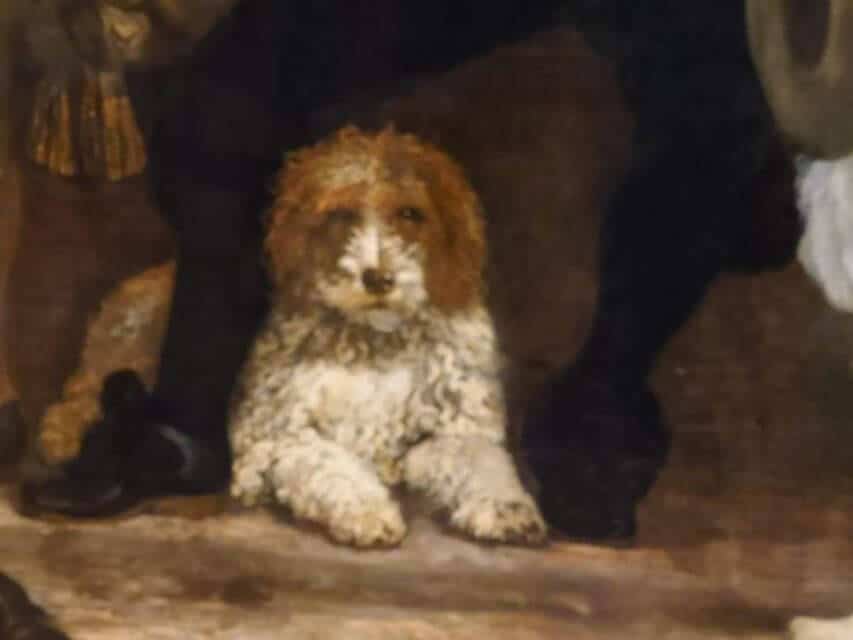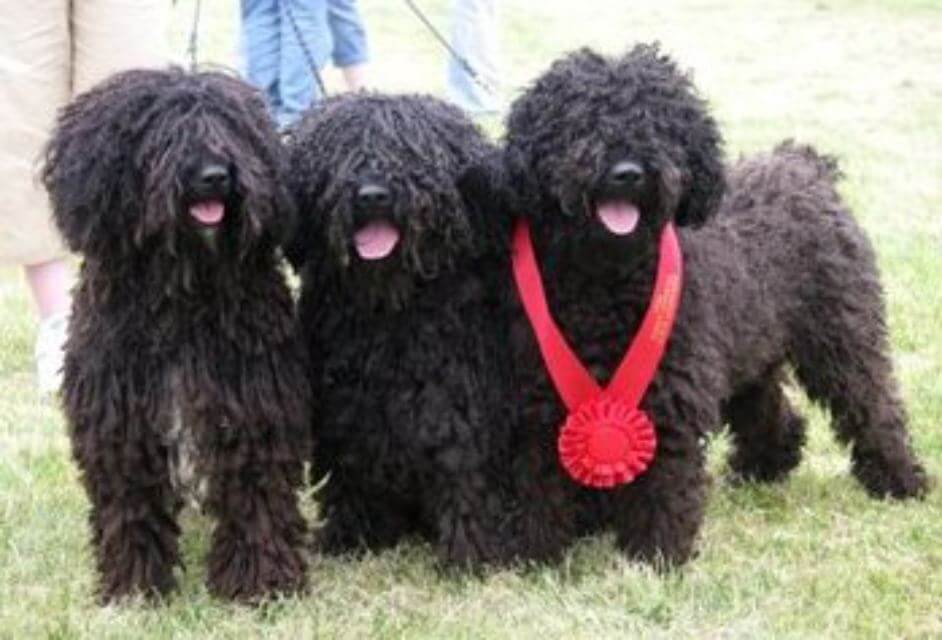


Home » Regarding the Spanish Water Dog’s Coat

Every part of a working breed evolves with the breed’s function, culture, geographical location, and climate. In this column, I’ll address questions regarding the Spanish Water Dog’s unique coat, development, and presentation in the show ring.
The Water Dogs of Spain, Portugal, and Italy almost certainly share an ancient curly-coated trunk breed. But as the breeds split by geography and function, the dogs’ toolset—including coats—evolved.

“The rustic coat is a hallmark of the breed. Any brushing, scissoring, aesthetic trimming or sculpting of the coat destroys breed type and must be penalized so severely as to eliminate the dog from competition. The hair is a single coat, always curly and of a woolly texture. For shows, the recommended extended length of the coat is between 1-6 inches to demonstrate the quality of the curl or cord. There is no preference for length of coat within this range. The sole breed clip is a utilitarian kennel clip, one length all over the entire dog. Left to grow long, coats will develop roughly pencil-thin cords that are distinct from those of other breeds in their degree of felting: from loose to tight, with the quality of the curl being evident throughout. Cords must have natural fish-hook curls at the tips indicating a lack of scissoring or shaping. Puppy coats: Puppy coat (up to 15 months) may be wavy and somewhat softer than adult coat. Most puppy coats will not form cords. Disqualification- Smooth or wavy coat.”

The Spanish call it “peeling the coat.” The breed was clipped to the skin once per year in the spring with the livestock. By summer, enough length had grown to provide protection from the sun. Large air pockets in the curls provided a sort of air-conditioning. Spain’s rainy season lasts from December through early May. With 1/3″-1/2″ of growth per month, by autumn the coat would be long enough to start forming cords, lifting light rains or snow away from the skin. Through winter, the denser cords with small air pockets retained heat. The area between the cords allowed air to get down to the skin and for the cords to dry faster. Retained moisture in compacted coats are a breeding ground for mildew or other unmentionable things. In spring, the dog would be ready for his coat to be “peeled” and the process started afresh.

Most of the cording breeds we see in the ring have dense double coats. They need that undercoat for the environment in which they live. It’s a part of their toolset. Their cords, made up of undercoat and guard hairs, are felted almost into cylindrical ropes. These breeds are not shorn annually, and if the cords are maintained they can be quite long.
The Spanish Water Dog, on the other hand, is a single-coated breed with little to no undercoat. Its cords are composed only of hair and are thinner than for double-coated breeds. The quality of the curl can be seen throughout. Additionally, as the rustic coat is NEVER to be trimmed, the cords have fish-hook curls at the tips.
How are cords made? Curly hair shafts are oval instead of round. While short, the curls are created by small areas curling together. As the hair curls, the scales lift slightly on the outside, hooking adjacent hairs and pulling together into loose cords. In the outdoor working animal, the elements play their part. Sun, water, and dirt help to draw the hairs together more tightly. Wind and motion encourage young cords to form independently of each other.

Lives of the US-resident SWD are very different from the working Spanish dog. In dry Spain, dogs live primarily outside. They are active and dry in the sunshine and wind. In contrast, most of our states have rain or snow. Our dogs live primarily indoors and lie down on carpeting or upholstery and enjoy air-conditioning in the summer. The curls are compacted and often take longer to dry, which promotes matting. So, we must manage the coat. Once the cords are set, maintenance is easy. Mats are located, hair is played away from the skin with the fingers, weak spots identified, and cords torn to the skin in one swift motion. Hairs that cross between cords soon pull those cords back together, so some folks opt to grasp those hairs and lightly pull them out. Ideally, dogs are allowed to romp and dry in the sun and fresh air. Lacking that, dogs can be crate-dried with box fans.
In Judges Education, we emphasize that all lengths are equally acceptable in the show ring. A fine dog in 2″ of coat should be put up over a lesser dog in full coat. The Standard recommends 1-6″ of length on the coat (roughly 2-12 months of growth) to demonstrate the quality of curl. The judge may want to stretch a curl out straight to determine the actual length of the hair, as curled hair appears much shorter than straight hair. The best place to judge the quality of the coat is on the back.

It can be a challenge for a judge who has exhibits with different lengths of coat. As we say, coat hides all things. But it can hide quality just as easily as faults. Rears can appear narrower, heads can appear broader, fronts can seem a little bulldoggy, bodies can appear longer and legs shorter. A rolling topline may be better hidden with a pre-corded coat, whereas short cords will emphasis it. The judge should depend on his hands as much as his eyes with this breed.
It can be a challenge for a judge who has exhibits with different lengths of coat. As we say, coat hides all things. But it can hide quality just as easily as faults.
Simply put, in Spanish Water Dogs, a groomed coat destroys breed type. Our rustic coat and cords are iconic to our breed’s silhouette and picture. Judges, handlers, and exhibitors who value breed preservation will adhere to the Breed Standard: “The rustic coat is a hallmark of the breed. Any brushing, scissoring, aesthetic trimming or sculpting of the coat destroys breed type and must be penalized so severely as to eliminate the dog from competition.”

